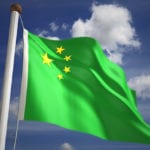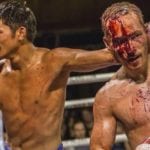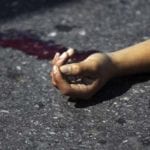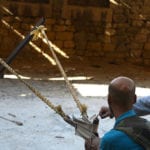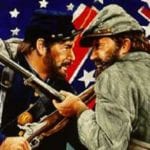 Creepy
Creepy  Creepy
Creepy  Movies and TV
Movies and TV 10 Movies That Get Elite Jobs Right, According to Experts
 Weird Stuff
Weird Stuff 10 Times Real Laws Were Based on Bizarre Hypotheticals
 Animals
Animals 10 Inspiring Tales of Horses Being Human
 Mysteries
Mysteries Top 10 Haunting Facts About the Ghost Ship MV Alta
 History
History 10 Surprising Stories About the Texas Rangers
 Humans
Humans 10 Philosophers Who Were Driven Mad by Their Own Theories
 Miscellaneous
Miscellaneous 10 Video-Game-Worthy Weapons and Armors from History
 Weird Stuff
Weird Stuff 10 Psychics Who Accurately Predicted Wartime Events
 The Arts
The Arts 10 Pieces of Art Inspired by a Broken Heart
 Creepy
Creepy 10 Death Superstitions That Will Give You the Creeps
 Movies and TV
Movies and TV 10 Movies That Get Elite Jobs Right, According to Experts
 Weird Stuff
Weird Stuff 10 Times Real Laws Were Based on Bizarre Hypotheticals
Who's Behind Listverse?

Jamie Frater
Head Editor
Jamie founded Listverse due to an insatiable desire to share fascinating, obscure, and bizarre facts. He has been a guest speaker on numerous national radio and television stations and is a five time published author.
More About Us Animals
Animals 10 Inspiring Tales of Horses Being Human
 Mysteries
Mysteries Top 10 Haunting Facts About the Ghost Ship MV Alta
 History
History 10 Surprising Stories About the Texas Rangers
 Humans
Humans 10 Philosophers Who Were Driven Mad by Their Own Theories
 Miscellaneous
Miscellaneous 10 Video-Game-Worthy Weapons and Armors from History
 Weird Stuff
Weird Stuff 10 Psychics Who Accurately Predicted Wartime Events
 The Arts
The Arts 10 Pieces of Art Inspired by a Broken Heart
Top 10 Brutal Reasons to Remember our Veterans
Today is Veteran’s Day (armistice day). It would be remiss of Listverse if we didn’t publish a list in their memory. The best way – we thought – to do that is to remind us all of the brutality and depravity of war – the horrifying things they experiences that we can barely even begin to imagine. 71,000,000 people died because of World War II. Here is a brief glimpse into what it was like. Let this list be a reminder of how horrible human nature can be and let us pray that such a thing never happens again. This is an extra list to supplement our usual two lists (which will be published shortly after this). If you have a family member whose name should be remembered on this sombre occasion, please name him in the comments.

The Hurtgen Forest spans 50 square miles of the Belgian-German border, an extremely rugged woodland with few roads or easily traversed ground. Field Marshal Walter Model commanded 80,000 Germans in its defense, against the American juggernaut of 120,000. From 19 September 1944 to late February 1945, the two armies met in a series of intricate, protracted battles and skirmishes that resulted in 23,000 battle casualties, both killed and wounded, for the Americans, in addition to 9,000 more from frostbite, trenchfoot, and pneumonia.
That winter was the coldest in a hundred years of Western Europe’s history, and the snow cover made the minefields and traps the Germans set impossible to discern. Very little American air cover was possible because of the thick woods. After an entire month of trying to sneak through interlocking fields of presighted artillery fire, the Americans had gained only 3,000 yards at a cost of 4,500 men killed or wounded.
The battle for the small town of Schmidt in the south resulted in more than twice the American casualties of Omaha Beach. Even with tanks, the daily advances never amounted to more than 600 yards until the start of the Ardennes Offensive, or Battle of the Bulge on 16 December. Schmidt wasn’t secured until 3 November. Model understood how to use the environment to aid his defense, and this battle remains the longest single engagement the U. S. Army has ever experienced.
Model’s goal was to slow the American advance long enough for the Ardennes Offensive to begin, then to flood the Rhine valley below via the Schwammenauel Dam. The Americans were unable to proceed in the entire area until 23 February. The Germans lost 12,000 dead and 95,000 taken alive. The U. S. military considers this a major strategic victory for the Germans.
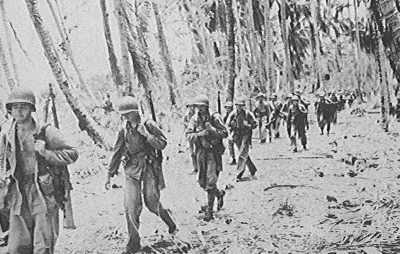
This 6-month long campaign lasted from August 1942 to February 1943, during which 60,000 Marines lost 7,100 dead, the U. S. Navy lost 29 ships sunk, and the U. S. Army Air Corps lost 615 planes shot down. The Japanese garrison of 36,000 men lost at least 31,000 killed in action, with only 1,000 captured, the rest unaccounted for, 38 ships sunk, and about 700 planes shot down.
Savo Sound, the stretch of water amid Savo Island, Florida Island, and Guadalcanal has been nicknamed Ironbottom Sound because of the 4 dozen ships sitting on the ocean floor. It is considered sacred to both navies and silence is observed whenever a ship passes through it.
While the navies dueled to the death off the coast, Guadalcanal was the scene of triple canopy jungle fighting of the same drawn-out attrition as that seen in Vietnam. The most bitter fighting was seen around the airstrip, renamed Henderson Field in honor of Lofton Henderson, killed in action at Midway; and “Edson’s Ridge,” also called “Bloody Ridge,” overseeing the airstrip and which the Japanese attempted to wrest from the Marines.
12,000 men Americans defended the airstrip on the ground while both air forces ought in the air almost non-stop for a month. On Edson’s Ridge, the Marines manned three hilltops and the Japanese, numbering over 3,000, stormed into the machine gun fire. The first night, their attack was defeated primarily by the jungle itself, but they pushed the Marines back to Hill 123 in the center. Then, on the second night, the Japanese were able to advance on 123 in force from the south and west, forcing the Marines into a horseshoe-shaped perimeter. The hill was 123 feet high, quite steep, and throughout the entire night, the Japanese were mowed down by the hundreds, only to reveal hundreds more behind them. The Marines were desperately short of ammunition and the battle became hand-to-hand all over the hillsides. The Japanese were unable to dislodge the Marines by dawn and withdrew with 850 dead, to the Marines’ 104.
A month later, with Henderson Field under heavy attack once again, John Basilone earned the Medal of Honor for manning three .30 caliber machine guns along his platoon’s section of the ridge, until there were only 2 Marines left fighting with him. Ammunition was in short supply. Twice he had to run back to the rear for more, until that ran out, but he personally cut down over 300 men, while repairing one machine gun and abandoning another due to a melted barrel. By dawn, he had only his .45 pistol and a knife. This was from 24 to 25 October. The battle raged like this until February.
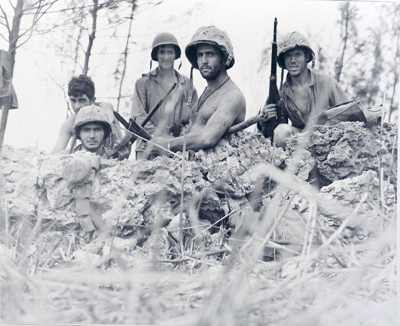
This one took place only a few months before the next entry, and indicated that though the Japanese had, by 1944, no chance of winning the war, they would fight to the death to kill as many Americans as they possibly could, and thus there could be no simple method by which to achieve their defeat. The island is about 44 square miles, and the Japanese stationed 30,000 troops on it. They fought to the bitter end for 3 weeks, with only 921 prisoners being taken. 21,000 died in action. 5,000 simply killed themselves in the caves.
The U. S. Navy preceded the invasion with 165,000 artillery shells, many of them 16 inches, pulverizing the island into a stewy morass of mud and limestone. On 15 June, the Marines stormed the shore and the defenders attempted to hold them on the beach itself, but Saipan showed for the rest of Japan that this could not be done, necessitating the change in strategy seen in #7 and #1, among others. By nightfall of D-Day, 15 June, the Marines had a beachhead of 6 miles long by half a mile deep, but the worst was to come shortly.
The Marines nicknamed features of the terrain, “Purple Heart Ridge,” “Hell’s Pocket,” and “Death Valley.” Hell’s Pocket was a deep gully amid several low hills, all nestled in the mountains on the west side of the island. When the Marines took it, the Japanese staged an immediate counterassault, and Battalion Surgeon Captain Ben Salomon repelled most of the attack himself, knifing 4 Japanese soldiers in order to defend the wounded on stretchers in his tent, then manning a .50 caliber machine gun and cutting 98 more in half while the wounded were evacuated to the rear. He was shot 76 times, and as many as 24 of these he suffered while still firing.
Saipan saw the largest single banzai charge of the entire war, when, at dawn on 8 July, General Yoshitsugo Saito led 3,000 drunken Japanese in addition to all the severely wounded, unarmed, limping and on crutches, in raiding the positions of the 105th U. S. Army Infantry. They and the Marines promptly killed more than 4,300 in hand-to-hand combat, swinging their M-1s until they broke, losing 650 dead and wounded in the process.
Another 22,000 civilians were also killed, several thousand by accidental napalming when the Marines mistook their huts for identical-looking Japanese sniper and machine gun nests. The civilians were indoctrinated by Emperor Hirohito himself to refuse to be taken alive, and some 17,000 killed themselves by jumping off the north cliff face.
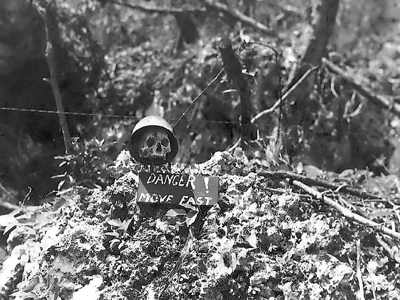
The Marine Corps refers to this as the single worst fight it had to endure in all of WWII. The American casualty rate was higher here than in any other battle of the war except #1. The invasion began on 15 September 1944, and the commanding general expected to be done in 4 days. The Japanese fought to the last man and their final cave strongholds were not reduced until 27 November.
Most of the battle was fought in 115 degree heat, and the Japanese took advantage of this by poisoning all the natural water supplies they could find. They typically dumped motor oil or rotting bull carcasses into them. The Marines anticipated this, but could only carry so much water, and when they quickly exhausted that, they ate salt tablets to retain it.
The Japanese refused all banzai charges, since they lost too many men doing so. Instead, they made stealth forays under the cover of darkness, bayoneting Marines in their foxholes, then disappearing up into the jungle ridges. The U. S. Navy shelled the entire island into a smoldering craterland of tree stems. The Japanese hid in caves they had carved out of solid granite, from which they raked the upward-advancing Marines with machine gun, mortar, and sniper fire. No part of the island was left uncovered by a Japanese emplacement, and the Japanese frequently shot down the stretcher bearers to entice more soldiers to their aid.
The single most difficult battleground of the whole war, according to many participants and historians, was Umurbrogol Mountain, near the top of which lay the infamous “Bloody Nose Ridge,” as the Marines called it. The mountainsides are interwoven ravines so steep that the Marines had to climb on all fours, pulling themselves up by the trees and rock faces, all the while taking heavy fire.
The 1st Battalion of the 1st Marines Division began this assault with about 800 men. After 5 days of fighting, the battalion had suffered 71% casualties. Captain Everett Pope led the 90 able-bodied men left in taking what he thought was the top of the mountain. It was merely another ridge below the summit, and the Japanese immediately poured down artillery fire from less than 70 yards to dislodge them. The Marines held the ground through the night, beating back 6 suicide charges with what little ammunition they had, then in hand-to-hand combat. One Marine bayoneted a Japanese soldier through the belly, then fired through him and killed another behind him, then was killed by a grenade.
By the end of the night, the Marines were throwing rocks mixed with their grenades to conserve ordnance. At dawn, they were forced to withdraw. In 73 days, the Marines had suffered almost 10,000 casualties, with 1,794 killed in 5 square miles. The Japanese had lost 10,695 killed in action. The final 72 combatants didn’t surrender from the caves until 1947.
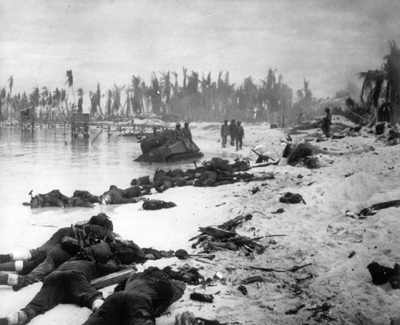
In terms of battlegrounds, this one may hold the record, at least on this list, of smallest area; the largest island, Betio, where most of the fighting took place, is just over a square mile. Yet the Japanese garrisoned 2,600 soldiers and another 2,200 workers on it to maintain and protect the airstrip. All 4,800 fought tooth and nail almost to the last man, something for which the Japanese would become famous beginning with this battle.
If there was an airstrip, the United States was sure to gun for it in its “island hopping” campaign. It was Tarawa that first roused the dissent of the American populace over this strategy, when, after only 3 days, 1,009 Marines were dead on the island, and the USS Liscome Bay, a carrier escort, was torpedoed and sunk to the tune of 687 dead sailors. Not just accounts, but photographs as well, were distributed nationwide to outraged citizens who had not expected such casualties.
The alternate strategy for forcing Japan’s capitulation was to send the entire U. S. Pacific Fleet to Japan, surround it, and shell it and bomb it into submission. Eventually this happened, but the Japanese submarines were a legitimate force to be reckoned with, and they, along with the U. S. POWs in Japanese prison camps all over the Pacific, were the two primary reasons why the U. S. Navy decided to take each of the important islands back, leading up to Japan.
It took the Marines 3 hours just to get onto the beach and reduce the shore artillery and machine guns. Not until Sherman tanks reached the shore could the Marines push off the beaches. Rear Admiral Keiji Shibazaki, the garrison commander, and his entire staff were directly struck and vaporized by 5 inch naval shells. This beach assault was just as bloody as that of Omaha Beach, Normandy.
Lt. Alexander Bonnyman won the Medal of Honor for waging a Rambo-like assault against multiple Japanese bunkers and pushing the Marine front line 400 yards inland, crossing almost a third of the island. He organized a 5-man squad that cleared the entire 1,000 yard Betio pier, then acquired flamethrowers and TNT from dead Marines, and destroyed 5 machine gun pillboxes.
The next day, having had no sleep, his squad advanced 40 yards ahead of their lines to assault a gigantic bunker housing 150 Japanese, and while running uphill at a 30-degree gradient, Bonnyman and his men threw over 3 dozen grenades into sniper holes, foxholes, and trapdoors, taking fully automatic rifle fire all the while, then ran back to their line for more grenades. When the renewed their assault, they took the top of the bunker and flushed the Japanese, where they were slaughtered. Bonnyman shot down 3 as they charged before he was shot and bayoneted to death.
On the last day, with only 3 strongholds left to reduce, some 150 Japanese fled a blockhouse into the open, about half of them down a trench. Those in the open were shot down in less than a minute. The Marines ordered those in the trench to surrender, promising they would not be harmed, but the Japanese kept running in single file for the beach. A Sherman tank aimed its main gun down the trench and fired, obliterating all of them.
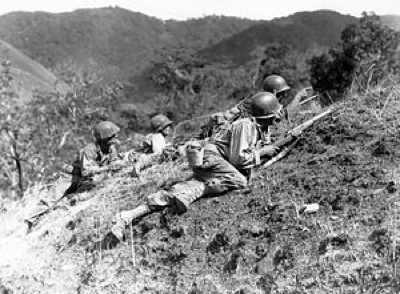
Luzon is the largest island in the Philippines, and the U. S. invasion, beginning 9 January 1945 lasted until August. General Douglas MacArthur’s promise to return included more than 173,000 men, who quickly overwhelmed the Japanese defenders in most areas of the jungle. Their fiercest resistance was staged in Manila, where 14,000 Japanese soldiers were besieged by 35,000 Marines and 3,000 Filipinos.
The Filipinos hated the Japanese for the tens of thousands of atrocious war crimes perpetrated on them in the three years prior. The city was surrounded easily, but taking it over required a whole month of urban carnage, the most horrible of the entire Pacific Theater, easily a match for that of Stalingrad. The entire city was utterly obliterated into a moonscape. Only Warsaw, Poland suffered worse for Allied cities. In terms of percentage of city destroyed, not even Hiroshima, Nagasaki, or Dresden was so devastated.
Intramuros, the original walled city of Manila, was razed completely to the ground. 1,010 Marines were killed, 5,500 wounded. At least 16,000 Japanese soldiers were killed in the city, including reinforcements. The toughest fighting centered on Provisor Island, where the Japanese entrenched themselves in bombed out factories. It was here that two Marines, Cleto Rodriguez and John Reese, left their platoon and assaulted the Paco Railroad Station, where two Japanese companies, numbering over 250, holed up, pouring withering fire on all American advances.
Rodriguez and Reese charged into a storehouse 60 yards from the station and shot dead 35 men over an hour, then pressed to the station and killed 40 more with their Thompsons. Reese covered Rodriguez while he ran up to the station and threw in 5 grenades, killing 7 more and destroying a 20mm flak cannon. Then they retreated, providing each other cover fire, while the Japanese rained down small arms and artillery barrages, until Reese was shot through the back and killed. Both men received the Medal of Honor. They had killed 82 Japanese soldiers and crippled their railway stronghold.
Under constant artillery and naval bombardment, the Japanese vented their anger on the unarmed, innocent men, women, and children of the city. Over 100,000 Filipino civilians, Red Cross personnel, even helpless hospital patients, were raped and tortured to death, many found skinned and still alive, disemboweled, castrated, and burned black. General Tomoyuki Yamashita, though he had no control over his men, was deemed responsible and hanged in 1946.
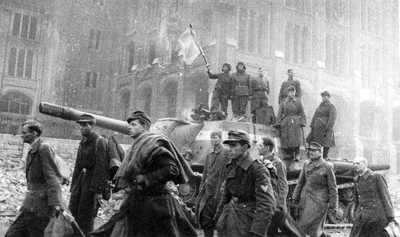
To look back at the War, you might say it wound up as two gigantic, punch-drunk heavyweights leaning on each other and slugging with whatever they had left in the tank until one of them collapsed. It seems that’s the way it had to end. Nazi Germany went down swinging, led into shame and ignominy by a sadistic monster. Hitler wasn’t crazy. He was mean. He enjoyed hurting people, and once it became clear to him that Germany could not overpower Russia, America, Great Britain, France, et al., he ordered all food and water taken from the German countryside to feed the army, and to let the populace starve. Anyone who had not joined the army, he said, was no friend of Nazi Germany.
The Supreme Commander of the Western Allies, Dwight Eisenhower, saw America’s alliance with Russia as tenuous at best, and elected not to participate in the battle, since Russia did not need the help, and American and Soviet forces would probably start firing at each other in the city. Three gargantuan Soviet army fronts pushed what was left of the Wehrmacht and Waffen SS back into Berlin and surrounded it.
Germany fielded 767,000 soldiers in the area around their capital, versus 2.5 million Soviets, and from 16 April to 2 May 1945, the end of the European Theater played out as everyone knew it would, atrociously. The Berlin city defenses consisted of 45,000 soldiers, exhausted and poorly equipped, several thousand Hitler Youth, as young as 11 years old, the Berlin city police, and the 40,000-strong Volkssturm, which were mostly veterans of WWI.
Once the Soviets pushed into the city proper, the battle degenerated into precisely what both nations experienced in Stalingrad 2 years earlier: house-to-house, close quarters combat. Soviet doctrine was to throw in a few grenades, then spray the room with submachinegun fire, then move through to the next, but the Germans held just as tenaciously as the Soviets had in their own cities. The foreign SS divisions fought to the death because they were under the impression that they would not be taken alive anyway.
Soviet records mention a particular staircase in a house near Alexanderplatz that a single police officer made his last stand. He was armed with an MP-40 and two PPSh-41 Soviet submachine guns, plus a handful of grenades. He exchanged fire back and forth for 6 minutes with the Soviets in the living room, retreating upstairs when he heard grenades rolling, then throwing down his own. He killed 8 men before running out of ammunition, and when the Soviets stormed the staircase, they found him armed with two bayonets, with which he killed 5 more before they clubbed him to death.
It was Stalingrad in reverse, but the Soviets were too bloodthirsty to care. Tens of thousands of rapes were committed against German women, and even men and children, as the Soviets flooded around the city. One Soviet soldier was found dead near the Berlin Zoo wearing a necklace of severed testicles.
The most bitter fighting took place at the Reichstag Building, which ironically had been derelict since a 1933 fire. The Germans manned it as a stronghold and the Soviets stormed it from all sides for 3 days, from 30 April to 2 May, in order to take it. The Germans were entrenched in the destroyed interior, and when the Soviets first entered the lobby, they were slaughtered by interlacing fields of machine gun and rifle fire. The lobby turned into a medieval killing field of over 2,000 corpses in less than an hour.
Hitler’s underground bunker lay only a quarter of a mile southeast of the Reichstag, and amid the incessant shelling, he shot himself while biting a cyanide capsule on 30 April. He blamed Germany’s failure and defeat on his generals.
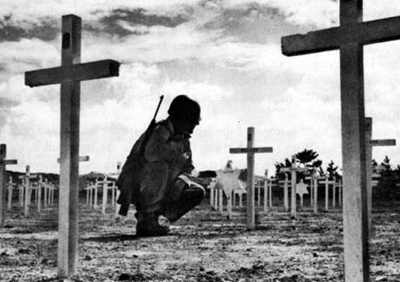
The last great battle of the whole god-awful mess was the deadliest of the Pacific Theater. For 82 days, from 1 April to 22 June 1945, 4 U. S. Army and 2 Marine Divisions, numbering some 170,000 men, swarmed over the island fighting 120,000 Japanese soldiers, not counting civilian conscripts, whom the Japanese army gave no choice but to fight. By the time it ended, Okinawa, formerly a 460 square-mile paradise of lush vegetation, was shelled, seared, and riddled into a fetid, blackened mire of flies and carrion birds.
At least 95,000 Japanese soldiers died fighting or by suicide. By comparison, 58,220 U. S. soldiers died in 12 years of the Vietnam War. 12,513 Americans were killed in action on Okinawa. Approximately 100,000 Okinawan civilians died as a result of accidents, war crimes of both sides, or starvation. This was up to one third of the population of the island. At the peak of the carnage, Americans sliding down hillsides into ravines to roust Japanese defenders from caves found their pockets full of maggots.
One of the most hotly contested positions became known as “the Pinnacle.” It was a 30-foot tall natural rock spire at the top of a 450-foot mass of twisted ravines and bare rock ridges strewn with boulders. The Americans twice tried to assault it but were twice beaten back by artillery, entrenched snipers, and grenades. A feint was finally ordered, with a company assaulting the north slope and retreating while another company assault the extremely rugged west slope. These men took the pinnacle without casualty and proceed to kill 100 of the 120 Japanese defenders with flamethrowers and incendiary demolition. The Pinnacle was merely an outpost, the first of over 200 overseeing Shuri castle and town, all of which were defended fanatically to the last man. Throughout the onslaught, Shuri Castle was shelled into oblivion by the USS Mississippi.
Some of the battle’s skirmishes took place entirely on top of the corpses of both sides. In 3 known instances, enemy squads of 4 or 5 men each sallied forth from their defensive positions and attacked each other with nothing but flamethrowers, not expecting that the other side would respond in kind. Lieutenant General Simon Buckner, Jr. became the highest ranking American casualty of the war when shrapnel from a Japanese artillery barrage ripped his chest open.
Generals Mitsuru Ushijima and Isamu Cho committed seppuku on the last day of fighting, having personally refused to surrender to Buckner. 90 percent of all human habitation on the island was blown up and burned to the ground.
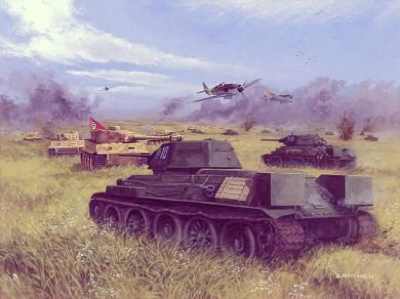
The 1943 Battle of Kursk remains the largest armored land engagement of all time, with the Germans fielding 2,900 tanks against the Soviets’ 5,100. Because of the vehicles, the battlefield was vast, covering over 11,000 square miles of steppe countryside. The Soviets had penetrated into the German lines and created a bulge or salient around the city of Kursk. The Germans intended to snip this bulge off with pincer moves from the north and south, then surround and annihilate the pocketed Soviet forces.
The Germans’ southern pincer flanked around the farming town of Prokhorovka, about 60 miles south of Kursk. The Soviet anti-tank defenses included ditches with sides too steep to be crossed, and in a field of only 50 square miles bounded on the north by these ditches and on the south by steep hills. 400 German tanks, including about 70 Tigers surprised about 600 Soviet tanks, some 400 of which were the heavy T-34. By 11 July, the Germans had drawn up to the western edge of this field and watched the Soviets at the eastern edge through binoculars.
On the morning of 12 July, the tank armies entered the field at 7:00 and engaged in the largest single tank battle of human history. For 8 hours, without stopping, tanks dueled shot for shot in quarters so close that the battlefield disappeared in dust and gun smoke from its commanders’ views. The Soviet T-34s could not stand one-on-one with either the Tigers or Panzers, but what one T-34 couldn’t do, 10 T-34s could: surround the German tanks like a swarm of ants and fire into their thin sides and rears. A simultaneous air battle was fought directly overhead by almost 5,000 planes, 2,100 German and 2,900 Soviet.
The T-34’s 75mm main gun could not penetrate the Tiger’s frontal armor, but the barrel itself could at full speed, and the Soviet tank crews simply crashed nose to nose into the Tigers, punching through into the interior, and fired, blasting the Tiger’s turret into the air. This routinely incinerated both 3-man crews. As opposed to the main Battle of Kursk, ongoing to the north, there were very few soldiers on the ground in support. One Soviet soldier was reported to exit a lightly-armored, burning T-70 while on fire, roll on the ground to extinguish it, then jump up and stagger up the side of the tracks of the Panzer that shot his tank. He dropped four grenades into the open hatch, then was blown up along with the Panzer by the shot of another Panzer’s 88mm main gun, driving out of the smoke 40 yards away. This tank had mistaken it for a Soviet target. Within forty seconds, a Soviet plane crashed nearby in a fireball.
The intensity did not wane until nightfall, when both sides withdrew. Neither side fairly claimed the battlefield, but the German Panzer Corps left completely, abandoning its goal of flanking and surrounding the Kursk salient. The Germans lost only 5 or 6 tanks utterly destroyed, with up to 90 severely damaged but operable. The Soviets lost as many as 330 utterly destroyed, with over 400 more severely damaged, but as always, they were able to replace their losses very quickly. The Germans could not.
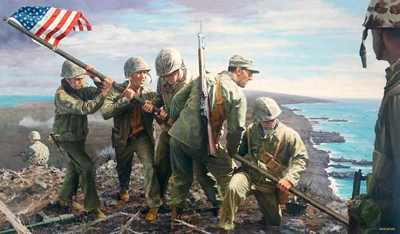
These 8 square miles (Manhattan Island is 3 times larger) became the site of what may be the most intensely violent single event in human history, which is saying a lot, unfortunately.
By the time of Iwo Jima, in February of 1945, the Japanese had figured out the proper, albeit still hopeless, defensive strategy against the United States military: dig in and prepare a defense in depth. It’s what the Russians used against the Nazis to magnificent effect. You don’t resist an unstoppable military machine; you allow it to come in close where the chances are closer to even.
Iwo Jima’s battlefield was given to General Tadamichi Kuribayashi, who disagreed with Japanese military concepts on many occasions, estranging him from several other members of the general staff. Most damning against him was that he refused to allow his men to engage in banzai charges, which were suicidal by definition, and in his view, horrible wastes of men and materiel.
So he had the Iwo Jima garrison prepare 16 miles of underground defensive foot routes, artillery emplacements, machine guns, pillboxes, sniper nests, spider holes, and then mined about 70% of the island. It took 2 years, with all of Japan’s military knowing full well a vicious fight would take place for Iwo Jima’s airstrip, the only one within 600 miles of Japan’s home islands. America couldn’t bomb Japan easily without it.
When the battle began, Kuribayashi had his men hold fire regardless of the suspense and danger, until the southeast and northwest beach assaults were well inland, trying to pinch off Mount Suribachi at the southwest. The Marines in the first waves were cut in half by machine gunfire, vaporized by gigantic, 12.6 inch spigot mortars, and could not dig into foxholes because the volcanic ash was made of moderately coarse, granular sand that would not compact or hold form. Its only blessing was a good absorption of artillery shrapnel.
28% of the Medals of Honor awarded to Marines during all of WWII were awarded just for actions on Iwo Jima. 27 men got one here, 5 of them sailors offshore. This testifies to a number of things, primarily that Japan got its defensive strategy correct with this battle. It fielded some 22,000 Japanese soldiers, and they lasted 36 days against some 70,000 United States Marines.
Once the first burst of automatic gunfire erupted, the carnage did not stop for over a month. Marines rarely saw the Japanese, but killed them by firing at muzzle flashes, or throwing grenades into bunkers, sniper nests, and pillboxes. Because the Japanese had prepared their underground paths so well, they were able to move dead soldiers away from the machine guns and resume fire into the backs of the Marines who thought they had just reduced an enemy emplacement.
The Marines finally improvised Sherman tanks with flamethrowers, which they nicknamed “Zippos,” to clear these bunkers and nests for good. On very rare occasions, the Japanese defenders had nowhere to run from this fire but out into the open, where they were shot down immediately or “curled up like bacon” in flamethrower blasts.
The average life expectancy of a Marine manning a heavy machine gun for a base of fire was 30 seconds. The iconic photograph of the flag being raised occurred on the 5th day of battle, after conquering Suribachi, but the worst of the fighting lay ahead in rugged, central Motoyama Plateau, which the Marines nicknamed “the Meatgrinder.”
One night during the assault on Hill 382 of the Meatgrinder, the Japanese became desperate, and led by Captain Samaji Inouye, 1,000 men charged the Marines. In less than 90 minutes, 874 men were shot down, blown to pieces, clubbed to death, or bayoneted, 784 Japanese and 90 Americans. In the morning, the Marines found intestines strung in the trees.
The last stronghold to be reduced was a 700 yard trench on the northwest coast. On the night of 25 March, 300 Japanese led by Kuribayashi himself charged Airstrip #2, and fought to the last man, killing 53 men of the Marines, Army pilots, and Seabees, most of them while sleeping, until they were engaged in hand-to-hand combat and slaughtered. One Marine fired until his M-1 Garand was empty, then swung it as a club until a Japanese officer cut it and the Marine in half with a sword. That officer was immediately disemboweled by another Marine’s combat knife, then stabbed through the mouth.
The next morning, the island was declared secure. Some 21,800 Japanese lay dead in and under the ground, and with them went 6,814 Americans, after 35 days of pure butchery.
